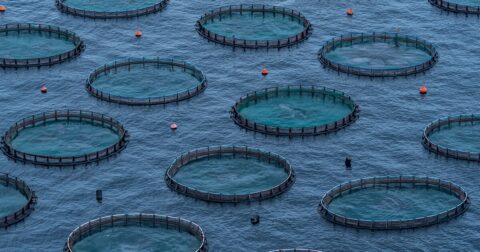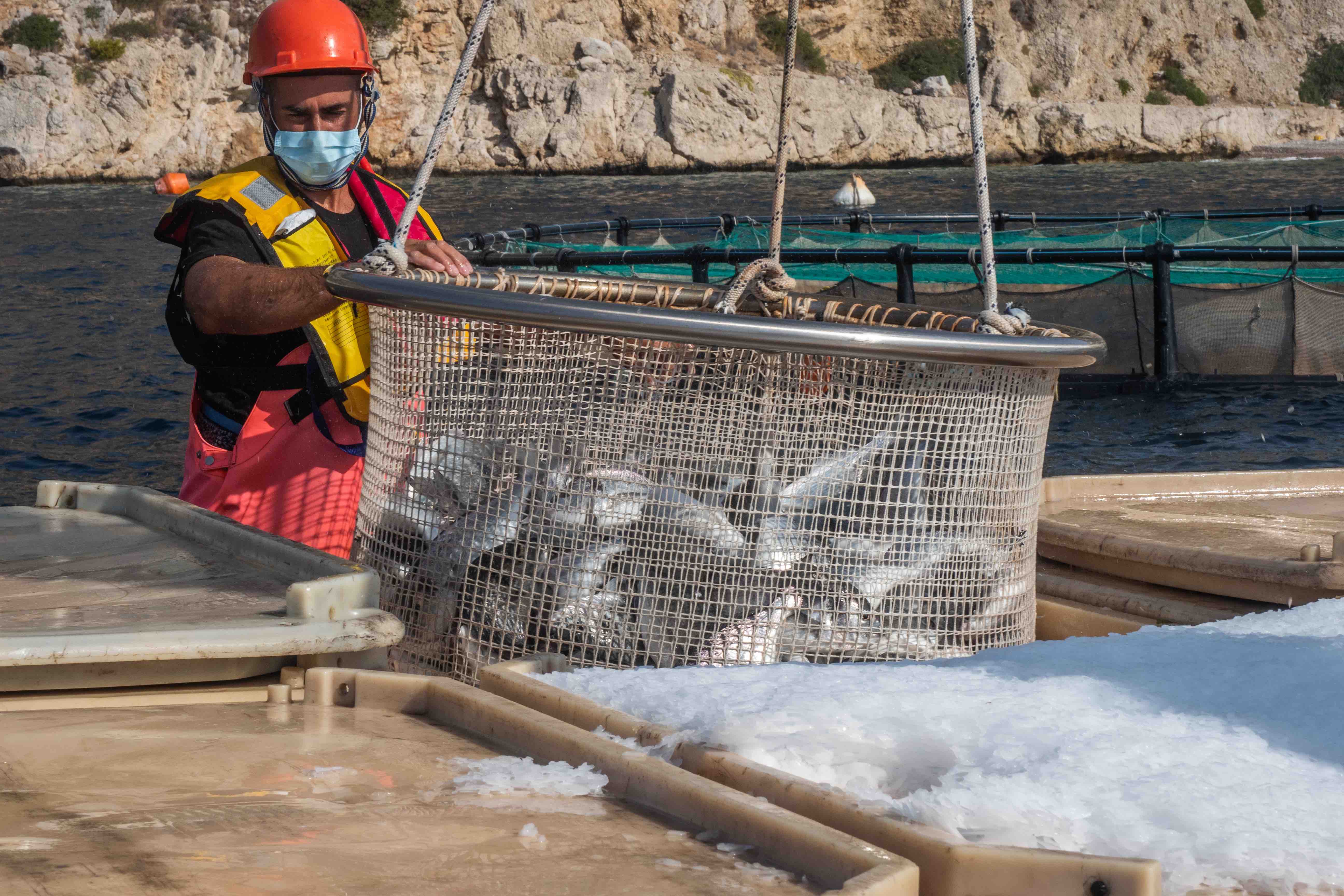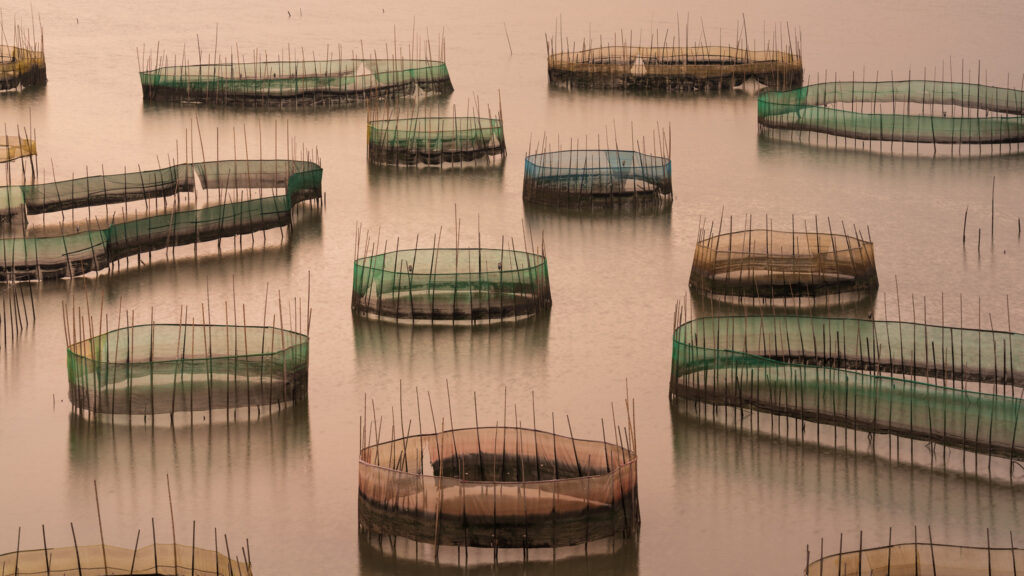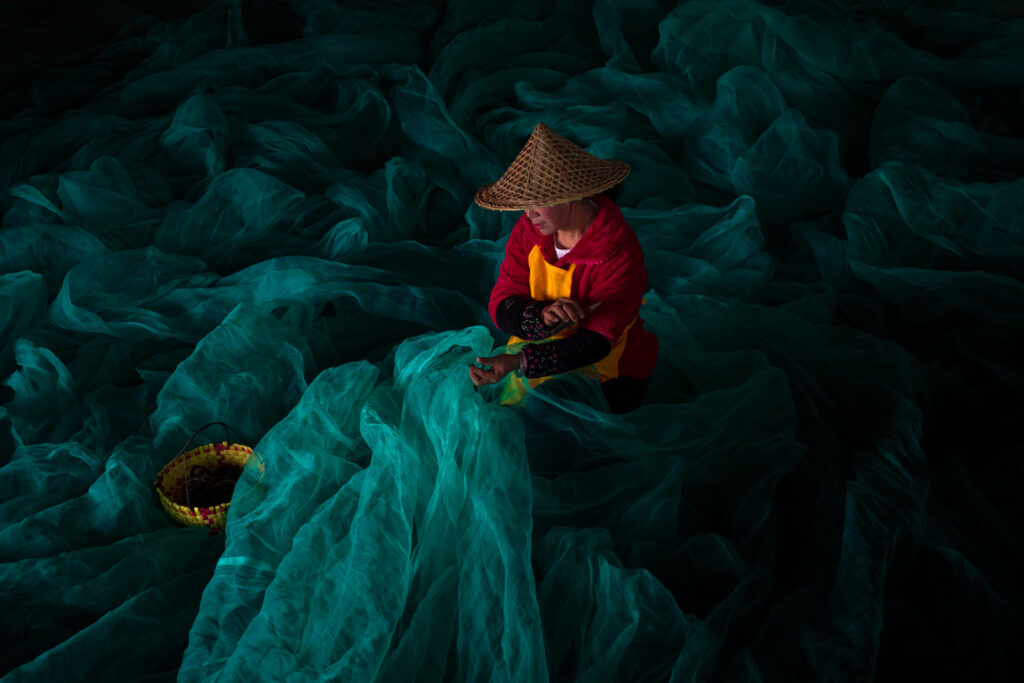Perspective
Critics Declared Veganism Dead in 2025. Here’s What Those Obituaries Are Missing.
Food•5 min read
Explainer
More fish are now raised on farms than are caught in the wild, making fish farmers an integral part of the seafood industry. However, they face a number of environmental and ethical challenges.


Words by Hemi Kim
Fish farming has grown significantly since the latter half of the 20th century, particularly in Asia, where it has been practiced for thousands of years. And in light of diminishing returns from the sea because of overfishing, and the perceived sustainability of raising fish instead of land animals as a protein source, fish farming has been described as a career of the future.
It is usually done by small-scale, subsistence farmers and farmworkers in the Global South. About 8 out of 10 farmed fish in 2018 originated in the following top five countries, according to the FAO via the Fish Welfare Initiative: China (50 percent), India (12 percent), Indonesia (8 percent), Vietnam (6 percent), and Bangladesh (4 percent).
But it depends on the type of fish you like to eat—diners ordering salmon in the United States might have greater reason to be concerned about fish farming practices in Chile. Egypt, Norway, Chile, Myanmar, and Thailand rounded out the top ten producers of farmed fish in 2018.
Fish farming, or pisciculture, is a subset of aquaculture, or water-based agriculture. A fish farmer is someone who raises fish in confined spaces as a way to efficiently turn fish food into fish flesh. Most of this flesh is used to directly feed humans (88 percent), while 12 percent is used for non-food purposes. Non-food purposes include fishmeal, fish oil, ornamental fish, breeding, bait, pharmaceutical purposes, pet food, or to directly feed livestock, fur, and aquaculture animals.
Carp, tilapia, and catfish are some popular examples of farmed fish. Finfish dominated the farmed production of aquatic animals in 2018, making up 54.3 million tons of fish meat, worth $139.7 billion. That’s nearly two-thirds of the 82.1 million tons of farmed aquatic animals (worth $250.1 billion) produced that year.
Beyond finfish, aquaculture includes the farming of shrimp, lobsters, oysters, mussels, other shellfish, and invertebrates. Aquaculture can also include the farming of frogs, aquatic turtles, algae, and aquatic plants like kelp and seaweed.
In 2013, global fish production through aquaculture surpassed the production of fish through capture fisheries, or catching fish in the wild.
The Sentience Institute estimates that nearly all farmed fish are living in a factory farm, comprising 78 percent of all farmed animals on the planet—although the available data is limited and does not use a standard definition of confinement.
Fish farmers typically choose the type of land or the body of water they want to work with and prepare it for raising fish in different ways, depending on the type of farm they have. Fish can be raised in earthen ponds, cages (or net pens), and tanks (also called raceways). Fish can also be farmed in rice fields, in a polyculture system alongside the rice. This type of farming is prevalent in Asia.
In traditional small-scale farms in Asia, production is pond-based and is generally more extensive than intensive, being run with limited human input. Yet the trend towards semi-intensive and intensive aquaculture and the active feeding of fish is growing, outpacing the growth of non-fed aquaculture, which mostly consists of mollusks and other invertebrates (17 million tons), and certain finfish (8 million tons) such as silver carp and bighead carp.

Fish can be farmed in fresh water, sea, or salt water, and a mix of the two known as brackish water. Fish can also be farmed using inland saline water, though most inland aquaculture uses fresh water, and most finfish farmed in salt water are produced in the sea. Most of the world’s farmed fish (62.5 percent, per the FAO) were produced through inland aquaculture, meaning rivers, lakes, and fish farms.
As with other animal-based industries, breeding and hatching fish can be the sole function of a fish farm. This farm can supply baby or small fish to other farms, for those farms to then grow the fish for harvest. Typically, slaughter, cleaning, and processing of the fish are done away from the farms by other private companies.
Raising and caring for fish involves purchasing or growing fry or yearlings (baby or smaller fish), maintaining good water quality and temperature, feeding the fish, and following health and welfare standards throughout. For example, a major problem for salmon farmers in Norway is getting rid of lethal parasites such as sea lice on a fish farm in a way that will not also harm wild salmon, and that will not build antimicrobial resistance.
In the United States, Block Corporate Salmon activists are upset with corporate fish farmers who have disregarded Indigenous people’s rights, as well as the environmental and health impacts of intensively farming genetically engineered fish.
To complete their role in the supply chain, fish farmers must also enter into agreements to sell their fish.
Being a fish farmer means being directly involved with animal agriculture. Farmers are attentive to the needs of other organisms—in this case, fish. They must be patient, observant, take initiative, work well in teams, and have an understanding of biology. Having excellent communication and business management skills is also useful.
While you do not need to get your shoes soaked in all types of fish farming, the nature of raising fish requires a willingness to work in wet environments like the sea, muddy ponds, or basins of water. Daily tasks for people engaged in fish farming tend to be physically demanding.
For many people, fish farming is a family business. In China, most aquaculture production is sourced from “rural, small-scale farms that are either privately or collectively owned, and often employ family or part-time workers,” according to a Fish Welfare Initiative report.

Governments generally attempt to regulate water quality, but poor-quality water and pollution can damage pond and caged fish farmers’ production in Nigeria, Israel, and Asian countries alike. Malaysian fish farmer Tan John Nin told Aljazeera in 2019, “We depend on the sea for a living. If our fish can’t survive, we are going to have to shut the farm. If there’s no fish in these waters, we’ll be out of a job as well.”
In Vietnam, fish farmers in 2020 reportedly struggled because of upstream dams in Cambodia and China, sand mining, and climate change. These factors outside their control contributed to increasing salt water levels and threatened their livelihoods.
The hours of a fish farmer are typically long and without holidays, year-round. Raising living organisms who are dependent on you means making sure their needs are met around the clock.
Most fish farmers run small-scale, family-based operations. Reports of fish farmer earnings in English-language, web-based media are not comprehensive, so the following facts will be based on news reports of mostly Asian farmers. Most (96 percent) of the 20.5 million people around the world employed in aquaculture in 2018 were in Asia, although these reports do not take into account expenses when reporting farmers’ earnings.
In Vietnam, one farmer reportedly had to purchase fresh water for her household and farm when the river water that she typically relied on was becoming too salinated. To combat the salt water that was destroying her farm, she bought more than ten cubic meters (2,642 gallons) of water, for which she paid about 1 million dongs ($42), a major unexpected expense. Even then, she still uses river water for doing laundry.
In 2011, one fish farming family in China reportedly made about 40,000 yuan ($6,288) to 50,000 yuan per year. In contrast, the annual U.S. poverty line income was $22,350 for a family of four in 2011. For context, the average annual income of residents between 46 and 50 years was about 34,447 yuan in China in 2011, according to the National Bureau of Statistics of China. Rural residents in 2011 earned an average net income of 6,977 yuan per year.
The family was in the news for seeking fair compensation for a dam relocation project that would see them lose their farm. In the 1980s, the family had spent roughly 700,000 yuan to “build two fish ponds measuring more than 70,000 cubic metres,” according to The Straits Times.
“Semi-intensive farm” owners tend to belong to lower-income households in India, per the Fish Welfare Initiative.
Fish prices dropped from about 40,000 dongs ($2) per kilogram (2.2 pounds) to about 15,000 dongs ($.064) per kilogram for one farmer in Vietnam in 2020. Small farmers in the Mekong Delta region were increasingly in debt and seeking supplemental work elsewhere.
Meanwhile, one Florida banker-turned-farmer was betting on pompano fish, which sold for $10–12 per pound wholesale. He estimated that it would cost substantially less than this to produce at his farm in 2017, according to the Palm Beach Post.
In a video on YouTube promoting a rice and fish farm in northeast India, Apatani women are bent at the waist, collecting fish with their hands in long, shallow, muddy channels of water lined with tall, spring-green grass. The fish are the size of their hands and end up in baskets carried on the backs of the farmworkers, to be sold at the market for a profit while the rice is kept for themselves.

At lunchtime the farmworkers prepare meals over a fire, cooking fish in a bamboo stem, and eating the fish with rice. After the fish harvest from July to September, the rice harvest occurs from September to October. The extensive but high-productivity agricultural practices and water management skills of the Apatani people in the Ziro Valley date back centuries, and are intertwined with Apatani cultural traditions and spiritual beliefs, though the “fish cum paddy culture” began in the 1980s.
Other videos provide depictions of more intensive operations in Singapore and the United Kingdom. Farmers are shown visually inspecting where the fish live, harvesting the fish by hand using nets, and then inspecting them again for the purposes of selling them. Farmers also weigh the fish and separate them by size. The work is always done by small teams of farmworkers.
A British carp farmer from VS Fisheries explains the rigors of harvesting fish: “It’s hard work, you’re working in the winter, you’re working in slippery, wet conditions, and it’s fair to say that just about every fish farmer has got a bad back, bad joints, bad arthritis and is falling apart. […] It’s a pleasure to put something back into the industry that I love.”
In the last 20 years, fish farmers in Asia produced 89 percent of the total volume of farmed fish worldwide. There are different types of production systems, but the job of rearing fish requires careful attention to land use, water quality, and feed, as well as harvesting them using nets or with one’s bare hands.
Fish farming is typically a collaboration of family members with the land they live on, but can also be run in larger operations, and even by multinational businesses. Farmed fish are raised in many ways: using ancestral methods in earthen ponds, net pens in the open sea, or above-ground tanks and cages with automated feeders.
It’s harder to find critical perspectives in English-language media about fish farming from farmers’ perspectives than it is in the chicken, beef, or pork industries, which may be related to the fact that most fish farmers are in Asia and the Global South. Yet advocates for fish welfare, environmental protections, consumer knowledge, Indigenous communities’ rights, and the farmers themselves have nevertheless still managed to highlight some of the struggles that farmers experience when producing 50 percent of the world’s seafood.